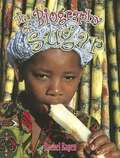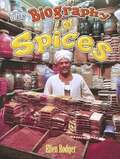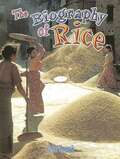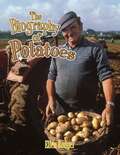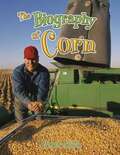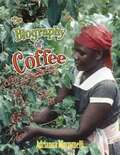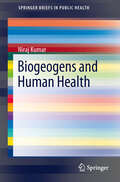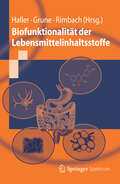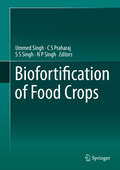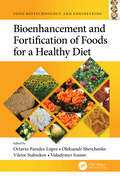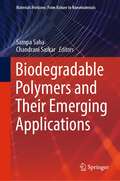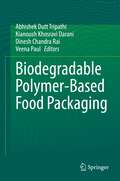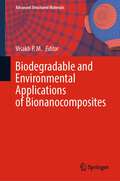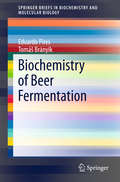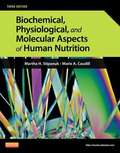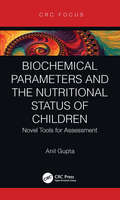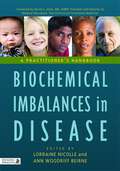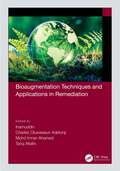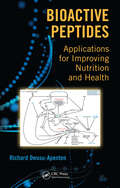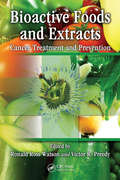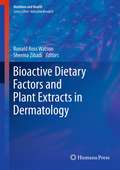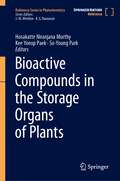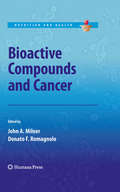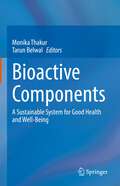- Table View
- List View
The Biography of Sugar (How Did That Get There?)
by Rachel EagenProvides a history of the processed sweetener, chronicling the evolution of international trade in the commodity, as well as describing the cultivation of sugar cane and sugar beets.
The Biography of Spices (How Did That Get There?)
by Ellen RodgerThis work is for ages 8-14. Empires were made from the growth and sale of spices and the age of discovery was launched in pursuit of them. Exciting text and historic images explain to children how spices were used to cure the sick, flavour foods, and make perfume. <p><p>Other topics include: What is a commodity?; What is a spice?; where spices originated and where they are grown today; how different spices are harvested, manufactured, and processed; the historical and modern spice trades; ancient peoples and how they used spices, from flavouring and preserving their foods, to the mummification of bodies!; how the Crusades changed European tastes; how the spice trade encouraged explorers and colonies; slavery and the spice trade.
The Biography of Rice (How Did That Get Here?)
by John Paul Zronik John ZronikThis work is for ages 8-14. Rice is one of the world's most important cereal crops. From wild plants in Asia and Africa, to its cultivation by ancient peoples 8,000 peoples years ago, rice has helped to shape the course of history. <p><p>Children will learn how rice is grown, harvested, processed and sold. Clear, descriptive images show how rice is a vital food crop for millions of people world-wide.
The Biography of Potatoes (How Did That Get Here?)
by Ellen RodgerSpanish conquistadors brought the potato from South America to Europe in the 1500s. Since then, the potato has helped keep peasants from starving, fed armies, and is today the world's most popular vegetable. The Biography of Potatoes underlines the importance of this source of nutrition.
The Biography of Corn (How Did That Get Here?)
by L. Michelle Nielsen L. Michelle NielsonMaize, or com, was the staple food of many early cultures in South America, Mesoamerica, and the Caribbean. <p><p>The Biography of Corn will teach young readers how the farming of corn spread to the rest of the world and how corn may be one answer to today's problem of fossil fuel consumption.
The Biography of Coffee (How Did That Get Here?)
by Adrianna MorganelliThis book is suitable for readers of ages 8-14. Coffee beans are the second most valuable commodity traded in the world. Young readers will be fascinated to learn how this popular product is grown, harvested, processed, and sold. Find out where coffee plants originated from and how coffee was spread around the world.
Biogeogens and Human Health (SpringerBriefs in Public Health)
by Niraj KumarHealth of the people is the most important indicator of the development of a nation. Health is a state of complete physical, mental and social well being and not merely the absence of disease or infirmity (as defined by WHO). The state of health of an individual or population depends upon complex interaction of the physical, biological, political and social domains. The environment affects the human health in a big way. People tend to be most susceptible to illness when physically or mentally stressed. Stress, energy and immunity form a closely knit network. Through his experimental findings, the author has brought out this intricate concept of interdependence of biotic (living) and abiotic (non-living) factors in an ecosystem, resulting in an impact on human health, in an explicitly marvelous manner. As a result, a new word "Biogeogens" has been coined, "bio" for living (biotic) , "geo" for non-living (abiotic/geographical/climatic/environment) and "gens" for the interactive proceeds of the two. The content included herein is directly concerned with the societal health and gives a clue to many socio-psycho health problems presently not handled with care. It also defines a multidimensional approach for dealing with many psychosomatic and health problems.
Biofunktionalität der Lebensmittelinhaltsstoffe (Springer-Lehrbuch)
by Gerald Rimbach Tilman Grune Dirk HallerFunktionelle Lebensmittel wirken nachweisbar stärker positiv auf die menschliche Gesundheit als normale. Das erste Lehrbuch zum Thema behandelt systematisch die Organfunktionen des Körpers und zeigt die Methoden, mit denen eine präventive Wirkung nachgewiesen werden kann. "Steckbriefe" aller relevanten Klassen von Lebensmittelinhaltsstoffen und deren Wirksamkeit bieten einen guten Überblick. Ergänzt wird das mit Abbildungen und Themenboxen anschaulich gestaltete Nachschlagewerk für Studenten und Lebensmittelexperten durch zahlreiche Fallbeispiele.
Biofortification of Food Crops
by Ummed Singh C S Praharaj S S Singh N P SinghThe chapters presented in this book 'Biofortification of Food Crops' depict how agricultural technological interventions have true role in alleviating malnutrition. This book highlights the role of multidisciplinary approaches to cope up with the challenges of micronutrient malnutrition or hidden hunger which is an alarming public health issue in most parts of the world including India. In this endeavour, different biofortification approaches such as agronomic (or ferti-fortification), breeding, biotechnological, physiological, microbial etc. has fulfilled their different mandates of nutrient enrichment of food crops including cereals and pulses. The contents of the book proves that biofortified plants have adequate potential to nourish nutrient depleted soils, help increase crop productivity and provide nutritional benefits to plants, humans and livestock. The content and quality of information presented in this book will definitely provide multiple novel ideas of advance techniques and will stimulate innovative thoughts and directions amongst researchers and policy makers in the field of biofortification. In addition, the contributions presented in the book will be a good source of background knowledge and technical know-how to educate the readers about biofortification. The authors hope that the book entitled "Biofortification of Food Crops" would provide a suitable platform in our collective efforts for an appropriate dialogue among the scientists, researchers, entrepreneurs, policy makers and farmers in reducing the budding issues of malnutrition through novel approaches and means.
Bioenhancement and Fortification of Foods for a Healthy Diet (Food Biotechnology and Engineering)
by Octavio Paredes-López Oleksandr Shevchenko Viktor Stabnikov Volodymyr IvanovBioenhancements of cereal and dairy compositions can play an important role in healthy diets. The latest addition to the new Food Biotechnology and Engineering series, Bioenhancement and Fortification of Foods for a Healthy Diet covers the technological and nutritional aspects of the compositions of cereals, dairy products, vegetables, and fruits. The book demonstrates real developments in food technology and reviews current knowledge in the biotechnological processing and bioenhancement of food. Key Features: Promotes the use of iron-containing nanoadditive in bakery and confectionary Explains the use of food additives for enrichment of butter mixtures Covers the use of artichoke powder and buckwheat bran in diabetic bakery products Describes the use of milk proteins in the technology of bakery products Proposes the use of spice compositions for sour milk products Organized in five parts, Bioenhancement and Fortification of Foods for a Healthy Diet addresses bakery and confectionery products, technologies for cereals enhancement, technologies for dairy products enhancement, food supplements, and finally, new technology processes. The book is an aide to food scientists and engineers contributing to the development of high-quality food products. Also available in the Food Biotechnology and Engineering series: Volatile Compounds Formation in Specialty Beverages, edited by Felipe Richter Reis and Caroline Mongruel Eleutério dos Santos (ISBN: 9780367631901) Native Crops in Latin America: Biochemical, Processing, and Nutraceutical Aspects, edited by Ritva Repo-Carrasco-Valencia and Mabel C. Tomás (ISBN: 9780367531409) For a complete list of books in this series, please visit our website at: https://www.routledge.com/Food-Biotechnology-and-Engineering/book-series/CRCFOOBIOENG
Biodegradable Polymers and Their Emerging Applications (Materials Horizons: From Nature to Nanomaterials)
by Sampa Saha Chandrani SarkarBio-degradable polymers are rapidly emerging as a sustainable alternative to traditional petroleum-based plastics and polymers. However, the synthesis and processing of such polymers present unique challenges and opportunities. In this comprehensive volume, Dr. Saha and her team provide an in-depth exploration of the synthesis and processing of bio-degradable polymers and their emerging applications in various sectors from drug delivery to food packaging. Covering a wide range of topics, including synthesis, modification, processing techniques, and few of their advanced applications in emerging areas, this book provides a comprehensive overview of the field. The authors also delve into cutting-edge research on the synthesis, properties and applications of bio-degradable polymers in various fields, such as agricultural, food preservation, biomedical arena, energy storage and other advanced application areas. This volume is an essential resource for scientists, engineers, and policymakers interested in the future of sustainable materials. Whether you are a researcher looking to expand your knowledge of biodegradable polymer synthesis and processing or a policymaker interested in the potential of biodegradable polymers to reduce our reliance on fossil fuels, this book is an invaluable guide to the field.
Biodegradable Polymer-Based Food Packaging
by Abhishek Dutt Tripathi Kianoush Khosravi Darani Dinesh Chandra Rai Veena PaulThis book covers different aspects of biodegradable packaging, such as their sourcing and application in food industries. The book focuses on the production and characterization of biodegradable food packaging derived from plant, animal and microbial sources. Chapters highlight the nano-technological interventions in biodegradable food packaging and the less studied microbial biopolymer-based biodegradable food packaging makes it distinct from other related books. It includes the latest research and development in the areas of food processing, food packaging, material science and polymeric science. It also discusses the standards and regulatory guidelines about the biodegradability testing of these polymers.This book is meant for researchers in food science, food packaging, bioprocess technology, polymer science and biochemical engineering. It is also beneficial for faculty members and students of food microbiology, food technology, dairy technology. The book is also meant for small entrepreneurs and farmers who are interested in bio-plastic usage for food packaging.
Biodegradable and Environmental Applications of Bionanocomposites (Advanced Structured Materials #177)
by Visakh P. M.This book provides cutting-edge, up-to-date research findings on the use of bionanocomposites in biodegradable and environmental applications, while also detailing how to achieve bionanocomposites preparation, characteristics, and significant enhancements in physical, chemical, mechanical, thermal properties and applications. This book on biodegradable and environmental properties of bionanocomposites provides a comprehensive and updated review of major innovations in the field of polymer-based bionanocomposites for biodegradable and environmental applications. It covers properties and applications, including the synthesis of polymer-based bionanocomposites from different sources biomaterials-based composites and tactics on the efficacy and major challenges associated with successful scale-up fabrication on bionanocomposites.It is an essential reference for future research in bionanocomposites as topics such as sustainable, biodegradable, and environmental methods for highly innovative and applied materials are current topics of importance. The book covers a wide range of research on bionanocomposite and their biodegradable and environmental applications. Updates on the most relevant polymer-based bionanocomposite and their prodigious potential in the fields of biodegradable and the environment are presented. Leading researchers from industry, academy, government, and private research institutions across the globe contribute to this book. Scientists, engineers, and students with interest in the most important advancements in the field of bionanocomposites involving high-performance bionanocomposites will benefit from this book which is highly application-oriented.
Biochemistry of Beer Fermentation (SpringerBriefs in Biochemistry and Molecular Biology)
by Eduardo Pires Tomáš BrányikBeer is the most popular alcoholic beverage in the world. Yet, behind each glass of beer there is an enormous amount of work invested. If the first image that comes to your mind is the lifting of heavy bags of malt or carrying kegs, guess again! Most of the work involved in brewing is carried out by "microworkers" - yeast and their enzymes! These special helpers are responsible for catalyzing the vast majority of the biochemical reactions occurring in all steps that gradually transform the sugary wort into beer. This book not only provides readers with an overview of the whole biochemical process involved in beer fermentation, but also reviews the latest findings in this delightful field, making it essential reading for both scientists and brewing enthusiasts
Biochemical, Physiological, And Molecular Aspects of Human Nutrition
by Martha H. Stipanuk Marie A. CaudillCovering advanced nutrition with a comprehensive, easy-to-understand approach, Biochemical, Physiological, and Molecular Aspects of Human Nutrition, 3rd Edition focuses on the biology of human nutrition at the molecular, cellular, tissue, and whole-body levels. It addresses nutrients by classification, and describes macronutrient function from digestion to metabolism. This edition includes the new MyPlate dietary guide and recommendations from the Dietary Guidelines for Americans 2010, plus coverage of the historical evolution of nutrition and information on a wide range of vitamins, minerals, and other food components. In Biochemical, Physiological, and Molecular Aspects of Human Nutrition, lead authors Martha H. Stipanuk and Marie A. Caudill are joined by a team of nutrition experts in providing clear, concise, coverage of advanced nutrition.
Biochemical Parameters and the Nutritional Status of Children: Novel Tools for Assessment
by Anil GuptaBiochemical parameters represent better, precise, and objective tools toward the assessment of the nutritional status of children in comparison to anthropometric, clinical, and dietary methods. They constitute laboratory tests to estimate the concentration of circulating nutrients in body fluids. Biochemical parameters are suggestive of acute or subclinical conditions when other methods of nutritional assessment fail to interpret the condition. These parameters exhibit substantial variability in their reproducibility. Moreover, these parameters are novel tools in the hands of clinicians for screening of the nutritional status of children. Key Features Covers the latest biochemical parameters for nutritional assessment Updated content is useful for clinicians, nutritionists, and general practitioners A unique and concise treatise covering descriptive and research-based work on a crucial health issue of worldwide prevalence About the Author Anil Gupta, PhD, is the Dean of Research at Desh Bhagat University and Professor and Head, Department of Physiology and Biochemistry at Desh Bhagat Dental College and Hospital, Mandi Gobindgarh, Punjab, India.
Biochemical Imbalances in Disease: A Practitioner's Handbook
by Smita Hanciles Jane Nodder Lorraine Nicolle Jean Monro Ann Woodriff Beirne Justine Bold Surinder Phull Helen Lynam Denise Mortimore Angelette Muller Zeller Pimlott Christabelle Yeoh Michael Ash Laurence Trueman Basant Puri Michael Culp Ada Hallam Kate NeilBiochemical imbalances caused by nutritional deficiencies are a contributory factor in chronic illnesses such as cardiovascular disease, diabetes, auto-immune conditions and cancer. This handbook for practitioners explains how to identify and treat such biochemical imbalances in order to better understand and manage a patient's ill-health. The book examines a range of biochemical imbalances, including compromised adrenal or thyroid function, gastro-intestinal imbalances, immune system problems and sex hormone imbalances, and explains how and why such states occur. It pulls together a wide range of evidence to show how such imbalances are involved in the most common chronic diseases. It helps practitioners to understand how to identify the imbalances through appropriate case history taking and laboratory testing, and how to design and implement effective nutritional interventions. Developed by leading academics and practitioners in the fields of nutritional therapy and functional medicine, this evidence-informed approach can be used with all patients who present in clinic, regardless of whether or not they have a 'named medical condition'. In the final chapter, a case example illustrates how to use the theoretical information in the practice of treating patients with chronically compromised health. Biochemical Imbalances in Disease is an essential text for nutritional therapy practitioners, as well as for students, and will be welcomed by complementary and conventional healthcare practitioners alike.
BioBalance: The Acid/Alkaline Solution to the Food Mood-Health Puzzle
by Rudolf A. WileyA host of problematic health conditions, including anxiety, depression, fatigue, insomnia, undiagnosable digestive and weight disorders, and PMS, are NOT, as previously and erroneously believed, stress-induced. Instead these symptoms are almost always the result of acid/alkaline imbalances in blood biochemistry which can be controlled nutritionally. If your life has become a nightmare of futile doctors' visits resulting in diagnoses like: "Everything is within normal limits,""You're suffering from too much stress,""Your problem seems to be psychological," then this book will change your life. The explanations in BioBalance: The Acid/Alkaline Solution uncover physiological reasons for seemingly undiagnosable problems.
Bioaugmentation Techniques and Applications in Remediation
by InamuddinIt has been observed that rapid population expansion has raised the amount of anthropogenic activity, resulting in high levels of pollution in water, air, and solid waste as well as an increase in the pressure placed on agricultural lands. Bioaugmentation Techniques and Applications in Remediation provides detailed information on bioaugmentation approaches for the remediation of sediments, water, and soil polluted with organic and inorganic pollutants. Practical applications of bioaugmentation techniques performed in restricted systems under controlled conditions, laboratory investigations, and in the field are addressed. Special emphasis is placed on the applications of nanomaterials in combination with bioaugmentation techniques for enhanced bioremediation efficiency. FEATURES Explores abiotic and biotic factors that enhance and facilitate environmental remediation of contaminants Provides a primer on the elementary microbial processes entailed in bioaugmentation Summarizes methods and approaches for executing bioaugmentation technology Details commercially available products and instrumentation This book is an ideal resource for researchers, students, and engineers working in materials science and bioremediation.
Bioactive Peptides: Applications for Improving Nutrition and Health
by Richard Owusu-ApentenChronic illnesses, injury, or infections produce a decline in muscle massleading to delayed recovery, more post-treatment complications, longer hospital stays, and higher mortality rates. Therefore, ensuring adequate lean body mass is of major concern in health care. Presenting data from human studies and trials, along with recent research findings
Bioactive Foods and Extracts: Cancer Treatment and Prevention
by Victor R. Preedy Ronald Ross WatsonThough there is considerable historical and anecdotal record for the use and efficacy of the cancer preventative properties of vegetables, fruits, and herbs, modern healthcare professionals require scientific evidence and verifiable results to make defensible decisions on the benefits, risks, and value of botanicals and their extracts in the preven
Bioactive Dietary Factors and Plant Extracts in Dermatology (Nutrition and Health)
by Ronald Ross Watson Sherma ZibadiThe role of Bioactive Dietary Factors and Plant Extracts in Preventive Dermatology provides current and concise scientific appraisal of the efficacy of foods, nutrients, herbs, and dietary supplements in preventing dermal damage and cancer as well as improving skin health. This important new volume reviews and presents new hypotheses and conclusions on the effects of different bioactive foods and their components derived particularly from vegetables, fruits, and herbs. Primary emphasis is on treatment and prevention of dermal damage focusing on skin cancers with significant health care costs and mortality. Bioactive Dietary Factors and Plant Extracts in Preventive Dermatology brings together expert clinicians and researchers working on the different aspects of supplementation, foods, and plant extracts and nutrition and skin health. Their expertise provides the most current knowledge in the field and will serve as the foundation for advancing future research.
Bioactive Compounds in the Storage Organs of Plants (Reference Series in Phytochemistry)
by Hosakatte Niranjana Murthy Kee Yoeup Paek So-Young ParkThis book offers a comprehensive and authoritative review of bioactive substances found in plant underground stems, roots, rhizomes, corms, and tubers from all around the world. Tubers and starchy roots are plants that store edible starch content in underground stems, roots, rhizomes, corms, and tubers. They are a key source for both human and animal consumption and are rich in carbohydrates. They are widely used as industrial crops as well. Phytochemicals found in tubers and roots, such as phenolics, terpenoids, and alkaloids, have anti-inflammatory, anti-cancer, hypoglycemic, hypocholesterolemic, and antibacterial properties. Except for common potatoes, sweet potatoes, and cassava, the nutritional and health benefits of many tuberous crops have not yet been adequately investigated. This book sheds new insights into these topics by addressing several plant metabolites found in storage organs, which can be seen as scientifically neglected even though they have a high economic relevance as food and pharmaceutical sources. Divided into 6 parts, this book discusses how bioactive chemicals found in plant storage organs are synthesized and how their bioactive principles are specifically expressed in underground stems, roots, rhizomes, corms, and tubers. Additionally, each chapter includes background information on the plant, its parts, its nutritional makeup, chemical components, and biological functions. Given its breadth, the book appeals to a wide readership, from scholars through graduate and post-graduate students to professionals in the industry.
Bioactive Compounds and Cancer (Nutrition and Health)
by John A. Milner Donato F. RomagnoloBecause of the wealth of new information generated by the scientific community during the last decade on the role of nutrition on cancer risk, this book provides a forum for presentation and discussion of recent scientific data and highlights a set of dietary recommendations. Bioactive Compounds and Cancer presents chapters that highlight laboratory and clinical findings on how selected nutrients function as signaling molecules and, as such, influence cellular behavior and cancer predisposition. This important compendium focuses on understanding the role of nutrition in cancer biology, the molecular action of bioactive food components and xenobiotics on cancer risk, the role of dietary components in cancer prevention and/or treatment, and nutrition education with the most up to date dietary recommendations that may reduce cancer risk. This volume will be of interest to specialized health professionals, clinicians, nurses, basic and clinical researchers, graduate students, and health officials of public and private organizations.
Bioactive Components: A Sustainable System for Good Health and Well-Being
by Monika Thakur Tarun BelwalThis book compiles updated information about the role and health benefits of various bioactives in food. Different chapters are contributed by academicians, food scientists, technologists, and medical practitioners. The book addresses both theoretical and applied aspects of bioactive components and provides exhaustive knowledge about bioactive components. It comprises 27 chapters organized into 4 major sections covering topics in food science and technology, functional foods, and nutraceuticals. It provides perspectives for innovation, sources, applications, and sustainability in bioactive component research. The first section starts with introduction of bioactive components consisting of seven different chapters primarily focusing on the bioactive components and their sources with respective health benefits. The second section, comprising five different chapters, deals with different technological trends, regulations, and safety aspects of bioactive components. With eight chapters, the third section covers the role of bioactive components in human health and the role of functional foods in combating various health-related issues. The fourth section reviews functional foods through six chapters that cover the use of bioactive components in various food products. The book will prove useful to advanced food technology graduate and undergraduate students and research scholars, practicing food technologists in food and related industries, entrepreneurs, food-pharma researchers, and other scientists seeking information about smart and sustainable processes as well as information needed to design and develop these processes.
